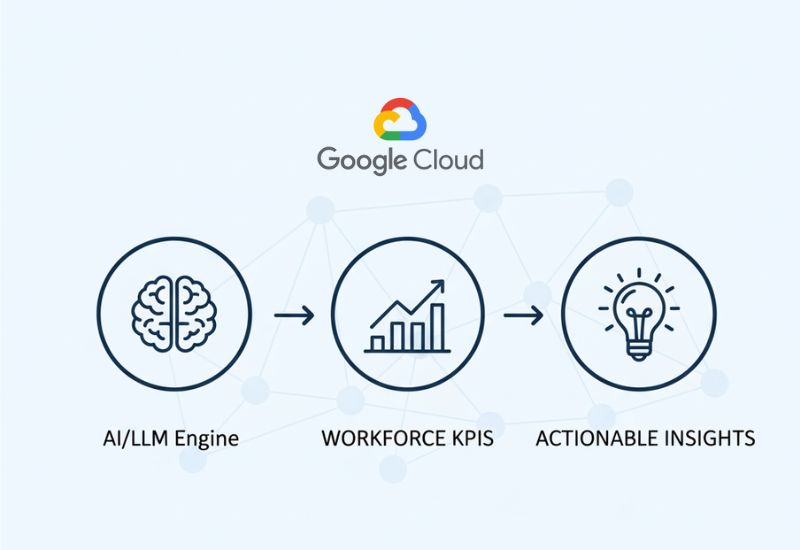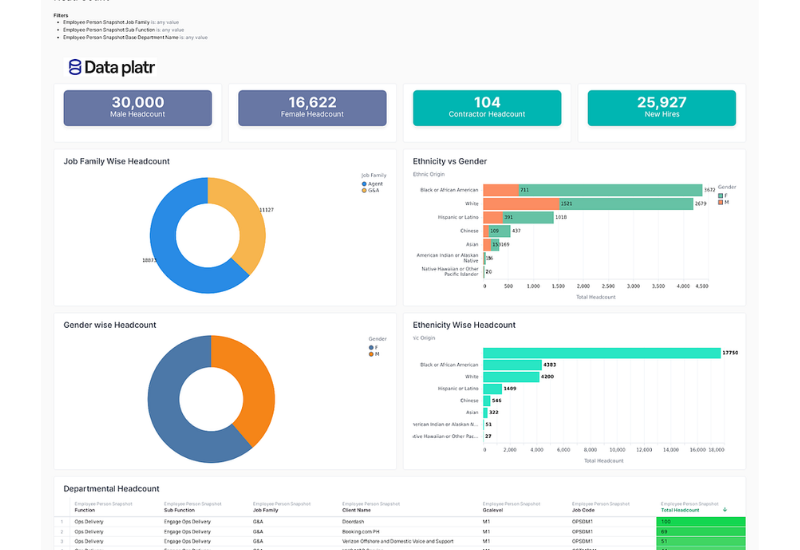What is a Data Lakehouse?
A data lakehouse is a system that brings together the best features of both data lakes and data warehouses. It allows businesses to store all kinds of data, structured like tables or unstructured like images or logs, in one place.
In the past, companies used data lakes to store raw data and data warehouses for organized, ready-to-use data. But this often caused problems like data duplication and slow workflows. A data lakehouse solves this by using one system for both storage and analysis.
This approach makes it easier to manage data, run reports, and support advanced tools like machine learning, all without moving data between systems.
By combining a data lake and a data warehouse, the data lakehouse architecture helps reduce cost, improve speed, and simplify operations.
Data Warehouse vs. Data Lake vs. Data Lakehouse
Understanding the difference between a data warehouse, a data lake, and a data lakehouse helps in choosing the right solution for your data needs.
Data Warehouse
A data warehouse stores structured data that is cleaned, organized, and ready for reporting or business analysis. It is fast and reliable for generating dashboards and running queries on historical data. However, it is often expensive and not designed to handle unstructured data.
Data Lake
A data lake stores large volumes of raw data in its original format. It supports both structured and unstructured data, such as text files, images, or logs. It is cost-effective but lacks features like data quality checks and consistent performance for analytics.
Data Lakehouse
A data lakehouse combines the strengths of both. It stores all types of data like a data lake while offering features like data reliability and performance similar to a data warehouse. It reduces data movement, simplifies architecture, and supports real-time analytics.
By bringing together the flexibility of a data lake and the structure of a data warehouse, a data lakehouse offers a balanced and efficient solution for modern data needs.
Features and Components of a Data Lakehouse
A data lakehouse is built to support a wide range of data and workloads in a single platform. Here are the key features and components that make it effective:
1. Unified Storage
It stores structured, semi-structured, and unstructured data together. This removes the need for separate systems like a data lake and data warehouse.
2. Data Management Layer
A data lakehouse architecture includes tools to manage data quality, apply schemas, and handle metadata. This helps keep data organized and easy to find.
3. Support for ACID Transactions
It allows multiple users to read and write data safely at the same time, without data loss or corruption.
4. Scalable Processing
It can handle both small and large workloads, from simple queries to complex analytics and machine learning.
5. Compatible with BI and ML Tools
It works well with popular business intelligence and machine learning tools, making it easier to build reports or models without moving data.
6. Cost Efficiency
Since it uses low-cost storage and reduces data duplication, it offers better value than managing both a data warehouse and a data lake separately.
These components make the lakehouse data lake model flexible, reliable, and efficient for modern data-driven businesses.
Implementing a Data Lakehouse
Implementing a data lakehouse involves setting up the right tools, structure, and processes to manage and use data effectively. Here’s how organizations typically approach it:
1. Choose the Right Platform
Start by selecting a platform that supports data lakehouse architecture. Popular choices include open-source and cloud-based tools that integrate storage and analytics.
2. Organize Your Data
Structure your data lake by setting up zones for raw, processed, and curated data. Apply naming conventions and data formats for easy access.
3. Add Governance and Security
Use access controls, encryption, and monitoring to protect sensitive data. Include data catalogs and documentation to support data discovery and compliance.
4. Enable Query and Processing Layers
Set up tools to process and analyze data in real time or in batches. These tools help users run reports, dashboards, and machine learning models directly on the lakehouse data lake.
5. Integrate with BI and ML Tools
Connect the lakehouse to business intelligence and data science tools so teams can gain insights without moving data elsewhere.
6. Monitor and Optimize
Track usage, performance, and storage. Improve efficiency by tuning queries, managing resources, and archiving outdated data.
By following these steps, businesses can fully use the benefits of a data lakehouse without managing separate systems for raw and structured data.
Benefits of a Data Lakehouse
A data lakehouse offers several advantages for businesses that work with large and varied data sets. Here are the key benefits:
1. Unified Architecture
A data lakehouse removes the need for separate systems like data lakes and data warehouses. This simplifies your data setup and reduces maintenance.
2. Cost Efficiency
Using affordable storage and reducing data duplication it helps lower infrastructure and operational costs.
3. Flexibility
It supports all data types, structured, semi-structured, and unstructured, making it easier to handle a wide range of use cases.
4. Real-Time Analytics
You can run fast queries and reports directly on raw or processed data without moving it to another system.
5. Machine Learning Ready
Data scientists can access large volumes of data quickly to build and train models, without waiting for complex data preparation.
6. Strong Data Governance
Data governance includes tools for managing data quality, access control, and compliance, which are often missing in traditional data lakes.
7. Scalability
A data lakehouse can scale to support growing data volumes and user demands while maintaining performance.
These benefits make the data lakehouse a powerful solution for modern businesses that need both flexibility and performance from their data systems.
Challenges of a Data Lakehouse
While a data lakehouse offers many benefits, it also comes with some challenges that organizations should be aware of before implementation.
1. Complex Setup
Integrating storage, processing, and analytics in one system requires careful planning. Choosing the right tools and architecture can take time and expertise.
2. Evolving Technology
The data lakehouse architecture is still developing. New features and updates are released often, which can lead to compatibility issues or learning curves.
3. Data Governance
Managing consistent data quality, access control, and security across all types of data can be harder in a unified system.
4. Performance Tuning
While lakehouses support large-scale analytics, they may need regular performance tuning to match the speed of traditional data warehouse systems.
5. Team Skills
Teams may need new skills to work with lakehouse data lake platforms. This includes understanding how to manage both raw and structured data in one place.
Despite these challenges, many companies find that the long-term benefits of a data lakehouse outweigh the initial complexities.
Popular Data Lakehouse Platforms
Businesses looking to adopt a data lakehouse approach have several platforms to choose from. Each of these solutions offers unique capabilities to unify storage, processing, and analytics:
1. Google Cloud Platform (BigLake)
BigLake unifies data lakes and warehouses on Google Cloud. It allows users to access structured and unstructured data with a single engine, making it easy to manage data at scale.
2. Snowflake
Snowflake supports data lakehouse architecture by enabling users to work with both structured and semi-structured data, offering high performance and easy integration.
3. Databricks Lakehouse
Databricks is a leading lakehouse data lake platform built on open standards like Delta Lake. It supports data engineering, analytics, and machine learning in one workspace.
4. AWS Lake Formation
This platform helps set up a secure and well-governed data lakehouse on AWS. It simplifies permissions, cataloging, and access to data across services.
5. Azure Synapse Analytics
Synapse combines data integration, big data, and data warehousing in a single platform, offering a strong foundation for a data lakehouse on Microsoft Azure.
6. SCIKIQ: Data Lakehouse & Analytics Platform
SCIKIQ is an all-in-one data lakehouse and analytics platform designed to handle diverse data sources with built-in data preparation, visualization, and AI capabilities.
7. IBM watsonx.data
IBM’s lakehouse data lake solution offers open data formats, workload flexibility, and governance features. It’s designed for AI and analytics workloads.
8. Teradata Vantage
Teradata Vantage supports multi-cloud data lakehouse environments, offering advanced analytics and strong performance across large-scale data.
9. Apache Hudi
An open-source project, Apache Hudi brings data versioning and incremental processing to data lakes, enabling data lakehouse functionality over raw storage.
10. Dremio
Dremio allows fast querying of data directly from lake storage without moving it. It supports a data lakehouse model with strong performance and self-service analytics.
These platforms help organizations bridge the gap between data lake and data warehouse systems, offering flexibility, speed, and scalability in one environment.
Conclusion
A data lakehouse represents a modern and unified approach to data architecture, combining the flexibility of data lakes with the performance and reliability of data warehouses. By enabling organizations to store, manage, and analyze all types of data in a single system, it reduces complexity, minimizes costs, and accelerates insights. While implementation may require new tools and skills, the long-term benefits, such as real-time analytics, machine learning readiness, and scalable performance, make the data lakehouse a compelling choice for data-driven businesses.
As technology continues to evolve, adopting a lakehouse model positions organizations to stay agile, competitive, and future-ready in an increasingly data-centric world.



























